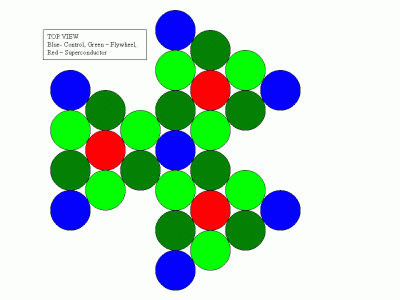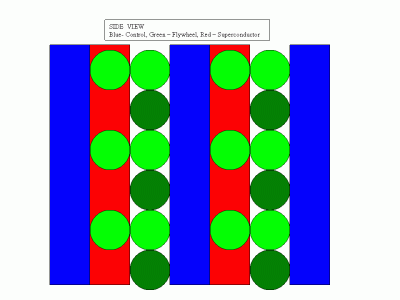BY LETTER
Nano-flywheels
Technology > Technology Type or Material > Drytech/Hylotech
Technology > Application > Everydaytech
Technology > Technology Levels > High Tech / Hitech
Technology > Technology Type or Material > Nanotech
Technology > Application > Everydaytech
Technology > Technology Levels > High Tech / Hitech
Technology > Technology Type or Material > Nanotech
 Image from John B |
The challenge of energy storage and transport has produced many, varied solutions, such as ultracapacitors, metastable materials and antimatter batteries. One mechanical method of energy storage which is widely used for a wide range of applications is arrays of micro-or nanoscale flywheels, on near-frictionless magnetic bearings, embedded in a solid, sealed, evacuated matrix. Energy is stored by the flywheels in the form of angular momentum. To effectively eliminate gyroscopic effects, the flywheels are free-floating within their enclosures. These flywheels are suspended in high-purity vacuum by magnetic bearings and have spin generated by 'touchless' inductance motors, which double as no-contact generators when power is drawn out of them. The matrix itself can be transported safely until the energy is required, then the angular momentum of the flywheels can be extracted and used, often by the generation of electrical power. Although the energy content of fully charged nano-flywheel matrix is quite high (on the same order as gasoline), the power density is somewhat lower than other methods of storage; this is because the energy can only be extracted at a relatively slow rate or the matrix will become damaged by overheating.
 Image from John B |
Note; the small amount of friction on the magnetic bearings can be converted to electrical energy which can be used; however over time this drain of energy will reduce the amount of energy stored, so nanoflywheel matrix is not suitable for longterm energy storage. This technology is most often used in small independent devices (such as swarm bots and synsects) which consume energy constantly and are frequently recharged.
Appears in Topics
Development Notes
Text by John B and Steve Bowers
Initially published on 23 October 2006.
Initially published on 23 October 2006.






